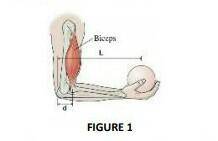
Physics, 19.11.2020 15:40 jamarstand
Figure 1 above shows an athlete's forearm holding a steel ball. The forearm is supported by a contraction of the biceps muscle, which causes a torque around the elbow. Assuming that the tension in the biceps acts along the vertical direction given by gravity and the centre of gravity of the forearm is half of L. What tension must the biceps muscle exert to hold the forearm at the position shown? Sketch and label your free body diagram. (Let L= 33.5 cm, d = 3.8 cm, mass of steel ball = 280 g, mass of the forearm = 2.5 kg)


Answers: 3
Another question on Physics

Physics, 22.06.2019 09:40
When you jump from an elevated position you usually bend your knees upon reaching the ground. by doing this, you make the time of the impact about 10 times as great as for a stiff-legged landing. in this way the average force your body experiences is a) less than 1/10 as great. b) more than 1/10 as great. c) about 1/10 as great.d) about 10 times as great.
Answers: 1


Physics, 22.06.2019 16:40
Aparticle's position is given by x = 3.00 - 9.00t + 3t2, in which x is in meters and t is in seconds. (a) what is its velocity at t = 1 s? (b) is it moving in the positive or negative direction of x just then? (c) what is its speed just then? (d) is the speed increasing or decreasing just then? (try answering the next two questions without further calculation.) (e) is there ever an instant when the velocity is zero? if so, give the time t; if not, answer "0". (f) is there a time after t = 3 s when the particle is moving in the negative direction of x? if so, give the time t; if not, answer "0".
Answers: 3

Physics, 22.06.2019 20:00
Abumper car with a mass of 250 kg is traveling at a speed of 4 m/s. this bumper car collides and sticks to a second bumper car with a mass of 250 kg, which is initially at rest. what is the final speed of these two bumper cars after the collision, assuming they remain stuck together?
Answers: 1
You know the right answer?
Figure 1 above shows an athlete's forearm holding a steel ball. The forearm is supported by a contra...
Questions


Chemistry, 28.02.2021 01:30




Mathematics, 28.02.2021 01:40



English, 28.02.2021 01:40


Mathematics, 28.02.2021 01:40



English, 28.02.2021 01:40

Mathematics, 28.02.2021 01:40



Mathematics, 28.02.2021 01:40





